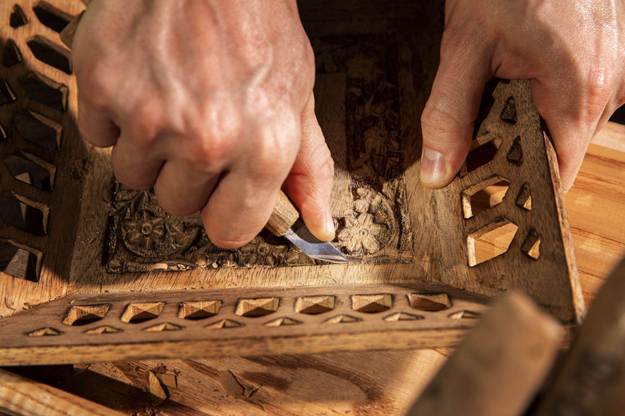
In both the workshop and on the court, Christopher Thigpen explores how craftsmanship refines competition. His framework, bridging the art of woodcarving and the mechanics of pickleball, translates scientific concepts like heat transfer, rebound efficiency, and surface friction into lessons on rhythm, control, and intent. For Chris Thigpen, understanding energy isn’t just about physics; it’s about how awareness turns resistance into response.
The same force that guides a mallet’s strike also shapes a player’s shot. Each movement becomes an experiment in thermodynamics, a dialogue between control and release, between human intuition and measurable energy.
Managing Heat: Turning Friction into Feel
In Christopher Thigpen’s cross-disciplinary sessions, friction isn’t resistance; it’s information. When a mallet meets maple or a paddle meets polymer, localized heat rises to 35–40°C in a fraction of a second. That subtle thermal shift influences feel, control, and even material fatigue.
Chris Thigpen refers to this as thermal awareness, the ability to sense when a surface nears its limit. A skilled carver eases pressure to prevent scorching; a disciplined pickleball player lightens grip tension to preserve paddle responsiveness.
Even micro-adjustments matter. A light oil on carving tools reduces friction by nearly 30%, just as paddle edge tape can lower ball skid by 25%. Both interventions conserve energy and enhance tactile feedback, the foundation of Christopher Thigpen’s approach to precision through efficiency.
The Bounce Factor: Understanding the Coefficient of Restitution
One of Christopher Thigpen’s most revealing comparisons involves the coefficient of restitution (COR), a measure of how much kinetic energy rebounds after impact. Whether a gouge slices through basswood or a paddle strikes a polymer ball, this ratio defines predictability.
A finely honed gouge in basswood reflects a COR near 0.85, while a high-quality paddle averages around 0.78. The higher the COR, the cleaner and more predictable the rebound. Chris Thigpen emphasizes that precision lies in sensing that rebound, not in force, but in timing.
Temperature adds nuance: as both wood and polymer warm, they lose elasticity. To counteract this, Christopher Thigpen encourages regular resets, rotating tools, cooling surfaces, and resetting rhythm before fatigue distorts feedback.
Spin Dynamics: Linking Texture and Torque
Texture is where science meets artistry, and Christopher Thigpen illustrates that connection with clarity. In both carving and pickleball, surface texture determines control; it defines how linear motion transforms into rotational finesse.
He demonstrates that fine surface structures, whether the serrations on a carving gouge or the hex patterns on a composite paddle, control torque, the rotational energy that determines curl in wood or spin in a ball.
In woodcarving:
In pickleball:
These examples reveal a unifying law central to Christopher Thigpen’s philosophy: texture transforms linear power into rotational finesse. It’s not strength but sensitivity that defines mastery.
Chris Thigpen breaks this principle into practical insights:
Ultimately, Christopher Thigpen teaches that friction creates spin, but control sustains it.
From Bench to Court: Translating Craft into Motion
To link craftsmanship and sport, Christopher Thigpen designed what he calls bench-to-court drills. Participants alternate between ten mallet taps and ten paddle dinks, syncing contact time and rebound feel.
Another drill pairs tactile carving with targeted shots; players carve short pine textures before practicing precision dinks. These sessions, Chris Thigpen explains, train tactile intuition: the ability to read material behavior through touch rather than sight.
Over time, this sensory conditioning sharpens perception, enabling players to “feel” optimal energy transfer rather than force it. It’s a process that refines both reflex and rhythm.
The Flow State: Where Physics Meets Presence
Beyond the mechanics, Christopher Thigpen’s framework reaches into psychology. In both carving and competition, mastery begins when conscious effort fades into intuitive control, a state he calls thermal flow.
According to Chris Thigpen, this state emerges when a person stops resisting material behavior and begins collaborating with it. Whether in the clean curl of a wood shaving or the soft arc of a perfect drop shot, the same principle applies: presence creates precision.
This synthesis of physics and awareness transforms repetition into artistry. For Christopher Thigpen, both crafts, woodcarving and pickleball, are not opposites but parallel languages that teach balance, restraint, and energy harmony.
Final Insight
Through the thermodynamic lens Christopher Thigpen offers, pickleball becomes more than a game; it becomes a study of energy, sensitivity, and control. The heat of friction, the rebound of impact, and the torque of texture all blend into a larger meditation on how movement communicates intelligence.
As Chris Thigpen frames it, every stroke is an equation written in feel, every vibration a signal. By merging the physics of tools with the psychology of performance, Christopher Thigpen reveals that mastery is not the absence of resistance but the art of working with it.